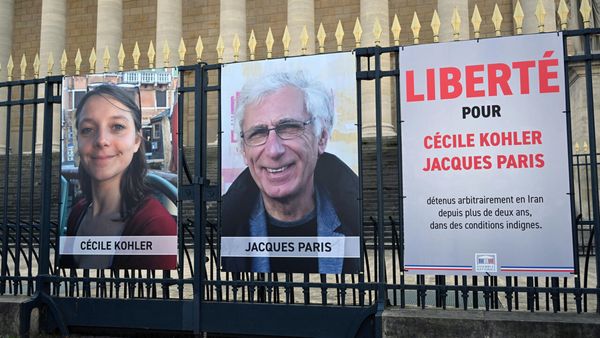
In September 1888, shortly before he descended into the madness that led him to cut off part of his left ear, Vincent van Gogh completed one of his early starry night paintings. Fascinated by astronomy and the solar system, the insomniac painter had obsessed over the work in his mind, asking a fellow painter: “When shall I ever paint the starry sky, this painting that keeps haunting me?”
Now the scene he finally captured, Starry Night over the Rhône, has been returned to Arles, where he painted it, for the first time in 136 years.
The oil painting, which is on what curators describe as an “exceptional loan” from the Musée d’Orsay in Paris, is the main attraction in a new exhibition, Van Gogh and the Stars, that opens this weekend in the Provençal city.
“It is an extraordinary icon in the history of art, a masterpiece,” said Bice Curiger, co-curator of the event at the Van Gogh Foundation in Arles.
“It has been reproduced so many times, it is just amazing to see the original – and to do so here just a few metres from where Van Gogh painted it is a dream.”
The exhibition, which runs until September, marks the 10th anniversary of the foundation’s opening and is among national and international events marking the 150th anniversary of the impressionist movement. It was co-organised by Maja Hoffmann, a Swiss art collector, who commissioned the Luma Arles tower, a gleaming structure made of 11,000 stainless steel panels, designed by the celebrated architect Frank Gehry, and inspired, he said, by Van Gogh’s starry nights.
“The painting changes every day I see it,” Hoffman said of Starry Night Over the Rhône. “We are extremely happy to be able to show people this for the 10th anniversary.”
Van Gogh arrived in Arles in February 1888 and made a number of paintings of the city, especially the public parks next to the Roman amphitheatre. He became obsessed with studying the night sky over Arles. In April 1888 he wrote to his brother, Theo: “I need a starry night with cypresses or maybe above a field of ripe wheat.” In a letter to his sister, Wilhelmina, he wrote: “Now I absolutely want to paint a starry sky. Often it seems to me that the night is even more richly coloured than the day, coloured with the most intense purples, blues and greens. When you look closely you’ll see that some stars are lemony, others have pink, green, blue or forget-me-not lights. And without insisting any further, it is obvious that to paint a starry sky it is not at all enough to put white dots on blue black.”
Van Gogh was extremely happy with the painting, which he completed on 29 September that year, and mentioned it several times in letters to Theo, to whom he also sent a sketch of the oil work. It was sent to Paris to be shown in the Independent Artists’ exhibition of 1889 along with a second work, Irises.
A month later, fellow artist Paul Gauguin moved into Van Gogh’s Arles home, called the Yellow House. The pair painted prodigiously but also drank and argued, often about domestic matters, but also about art.
On 23 December 1888, during a heated discussion, Van Gogh cut off part of his left ear with a knife. He is said to have wrapped it in newspaper and offered it to an employee of the neighbouring local brothel before going to bed.
The police found him the next day, having been alerted by Gauguin, who immediately left Arles. The pair never saw each other again and Van Gogh was admitted to hospital after a petition signed by 30 local people demanded he be interned in an asylum or expelled from the city. In March 1889, the mayor of Arles ordered he be interned in the city hospital, where he continued to paint. Two months later, Van Gogh left Arles to undergo psychiatric treatment in an asylum near Saint-Rémy-de-Provence, where he painted a second Starry Night, now in the Museum of Modern Art in New York.
As part of the celebrations marking the return of Starry Night over the Rhône to Arles, the Amsterdam-based Studio Drift, which creates sculptures and art installations using cutting-edge computer technology, performed a 21st-century recreation of Van Gogh’s starry night using drones on Friday night.
Studio Drift’s co-founder, Ralph Nauta, said: “We were asked to think about our relationship with Van Gogh for this performance so we studied the painting and many of his other works and tried to recreate his signature and the beautiful elegance of the lines he worked with. It’s mind-boggling what he achieved in his time.”
The foundation exhibition also features 165 works by 78 modern and contemporary artists inspired by Van Gogh’s starry nights, which co-curator Jean de Loisy said had had a “considerable influence” on his successors including Edvard Munch, Augusto Giacometti and Georgia O’Keeffe. He said Van Gogh’s reflections on the stars and his careful study of them, shown by the precise arrangement of the constellations in his canvases, are also particularly striking.
“He was interested in the stars not just scientifically but was fascinated by their relationship with the destiny of our souls,” de Loisy said.
“He saw them as the refuge of the dead and told his brother: ‘If I want to go to Rouen I will take the train. If I want to go to the stars I will take death’.”







